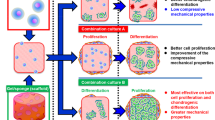Abstract
Conventional methods for differentiation of chondroprogenitor cells on plastic plates face several problems that hinder the application of this method for the treatment of chondrogenic injury. This work focused on the effect of poly-l-lysine (PLL)-coated plastic surfaces and fetal calf serum concentration on the chondroprogenitor cells. In the present study, cartilage was isolated from the articular cartilages of sheep and the cells were seeded on PLL-coated plates in various serum concentrations. Histochemical analysis was used to determine chondrogenic differentiation of the cells. According to our results, the cells formed three-dimensional masses and chondrogenic cells. In the present investigation, the best culture conditions for maximum proliferation of isolated cells were examined. Taken together, the results indicated that PLL may have some effect on the adhesive properties of chondroprogenitor cells and could be used for cartilage engineering.
Similar content being viewed by others
References
Jackson DW, Scheer MJ, Simon TM. Cartilage substitutes: overview of basic science and treatment options. J Am Acad Orthop Surg 2001;9(1):37–52
Mankin HJ. The reaction of articular cartilage to injury and osteoarthritis (first of two parts). N Engl J Med 1974;291(24):1285–1292
Caplan AI. Stem cell delivery vehicle. Biomaterials 1990;11:44–46
Mizuno S, Glowacki J. Three-dimensional composite of demineralized bone powder and collagen for in vitro analysis of chondroinduction of human dermal fibroblasts. Biomaterials 1996;17(18):1819–1825
Levy MM, Joyner CJ, Virdi AS, Reed A, Triffitt JT, Simpson AH, Kenwright J, Stein H, Francis MJ. Osteoprogenitor cells of mature human skeletal muscle tissue: an in vitro study. Bone 2001;29(4):317–322
Huang JI, Beanes SR, Zhu M, Lorenz HP, Hedrick MH, Benhaim P. Rat extramedullary adipose tissue as a source of osteochondrogenic progenitor cells. Plast Reconstr Surg 2002;109(3):1033–1041; discussion 1042–1043
Bosch P, Musgrave DS, Lee JY, Cummins J, Shuler T, Ghivizzani TC, Evans T, Robbins T, Huard D. Osteoprogenitor cells within skeletal muscle. J Orthop Res 2000;18(6):933–944
Doherty MJ, Ashton BA, Walsh S, Beresford JN, Grant ME, Canfield AE. Vascular pericytes express osteogenic potential in vitro and in vivo. J Bone Miner Res 1998;13(5):828–838
Zuk PA, Zhu M, Mizuno H, Huang J, Futrell JW, Katz AJ, Benhaim P, Lorenz HP, Hedrick MH. Multilineage cells from human adipose tissue: implications for cell-based therapies. Tissue Eng 2001;7(2):211–228
Cancedda R, Dozin B, Giannoni P, Quarto R. Tissue engineering and cell therapy of cartilage and bone. Matrix Biol 2003;22(1):81–91
De Bari C, Dell’Accio F, Tylzanowski P, Luyten FP. Multipotent mesenchymal stem cells from adult human synovial membrane. Arthritis Rheum 2001;44(8):1928–1942
Dowthwaite GP, Bishop JC, Redman SN, Khan IM, Rooney P, Evans DJ, Haughton L, Bayram Z, Boyer S, Thomson B, Wolfe MS, Archer CW. The surface of articular cartilage contains a progenitor cell population. J Cell Sci 2004;117(Pt 6):889–897
Nadri S, Soleimani M. Comparative analysis of mesenchymal stromal cells from murine bone marrow and amniotic fluid. Cytotherapy 2007;9(8):729–737
Digirolamo CM, Stokes D, Colter D, Phinney DG, Class R, Prockop DJ. Propagation and senescence of human marrow stromal cells in culture: a simple colony-forming assay identifies samples with the greatest potential to propagate and differentiate. Br J Haematol 1999;107(2):275–281
Nadri S, Soleimani M, Kiani J, Atashi A, Izadpanah R. Multipotent mesenchymal stem cells from adult human eye conjunctiva stromal cells. Differentiation 2008;76(3):223–231
De Bari C, Dell’Accio F, Luyten FP. Human periosteum-derived cells maintain phenotypic stability and chondrogenic potential throughout expansion regardless of donor age. Arthritis Rheum 2001;44(1):85–95
Fickert S, Fiedler J, Brenner RE. Identification, quantification and isolation of mesenchymal progenitor cells from osteoarthritic synovium by fluorescence automated cell sorting. Osteoarthritis Cartilage 2003;11(11):790–800
Ito Y, Fitzsimmons JS, Sanyal A, Mello MA, Mukherjee N, O’Driscoll SW. Localization of chondrocyte precursors in periosteum. Osteoarthritis Cartilage 2001;9(3):215–223
Schaefer D, Martin I, Jundt G, Seidel J, Heberer M, Grodzinsky A, Bergin I, Vunjak-Novakovic G, Freed LE. Tissue-engineered composites for the repair of large osteochondral defects. Arthritis Rheum 2002;46(9):2524–2534
Ishizeki K, Chida T, Yamamoto H, Nawa T. Light and electron microscopy of stage-specific features of the transdifferentiation of mouse Meckel’s cartilage chondrocytes in vitro. Acta Anat (Basel) 1996;157(1):1–10
Lunstrum GP, Keene DR, Weksler NB, Cho YJ, Cornwall M, Horton WA. Chondrocyte differentiation in a rat mesenchymal cell line. J Histochem Cytochem 1999;47(1):1–6
Villar-Suarez V, Calles-Venal I, Bravo IG, Fernandez-Alvarez JG, Fernandez-Caso M, Villar-Lacilla JM. Differential behavior between isolated and aggregated rabbit auricular chondrocytes on plastic surfaces. J Biomed Biotechnol 2004;(2):86–92
Villar-Suarez V, Colaco B, Calles-Venal I, Bravo IG, Fernandez-Alvarez JG, Fernandez-Caso M, Villar-Lacilla JM. Effects of extracellular matrix on the morphology and behaviour of rabbit auricular chondrocytes in culture. J Biomed Biotechnol 2005;(4):364–373
Schulze-Tanzil G, de Souza P, Villegas Castrejon H, John T, Merker HJ, Scheid A, Shakibaei M. Redifferentiation of dedifferentiated human chondrocytes in high-density cultures. Cell Tissue Res 2002;308(3):371–379
Chien CC, Yen BL, Lee FK, Lai TH, Chen YC, Chan SH, Huang HI. In vitro differentiation of human placenta-derived multipotent cells into hepatocyte-like cells. Stem Cells 2006;24(7):1759–1768
Chen AC, Nagrampa JP, Schinagl RM, Lottman LM, Sah RL. Chondrocyte transplantation to articular cartilage explants in vitro. J Orthop Res 1997;15(6):791–802
Ehlers EM, Behrens P, Wunsch L, Kuhnel W, Russlies M. Effects of hyaluronic acid on the morphology and proliferation of human chondrocytes in primary cell culture. Ann Anat 2001;183(1):13–17
Woodward WA, Tuan RS. N-Cadherin expression and signaling in limb mesenchymal chondrogenesis: stimulation by poly-l-lysine. Dev Genet 1999;24(1–2):178–187
Penick KJ, Solchaga LA, Welter JF. High-throughput aggregate culture system to assess the chondrogenic potential of mesenchymal stem cells. Biotechniques 2005;39(5):687–691
Author information
Authors and Affiliations
Corresponding author
Additional information
The first two authors contributed equally to this work.
Rights and permissions
About this article
Cite this article
Atashi, A., Nadri, S., Hafizi, M. et al. Role of poly-l-lysine-coated plates and fetal calf serum concentration in sheep chondroprogenitor cell culturing. J Artif Organs 12, 118–122 (2009). https://doi.org/10.1007/s10047-009-0450-y
Received:
Accepted:
Published:
Issue Date:
DOI: https://doi.org/10.1007/s10047-009-0450-y




